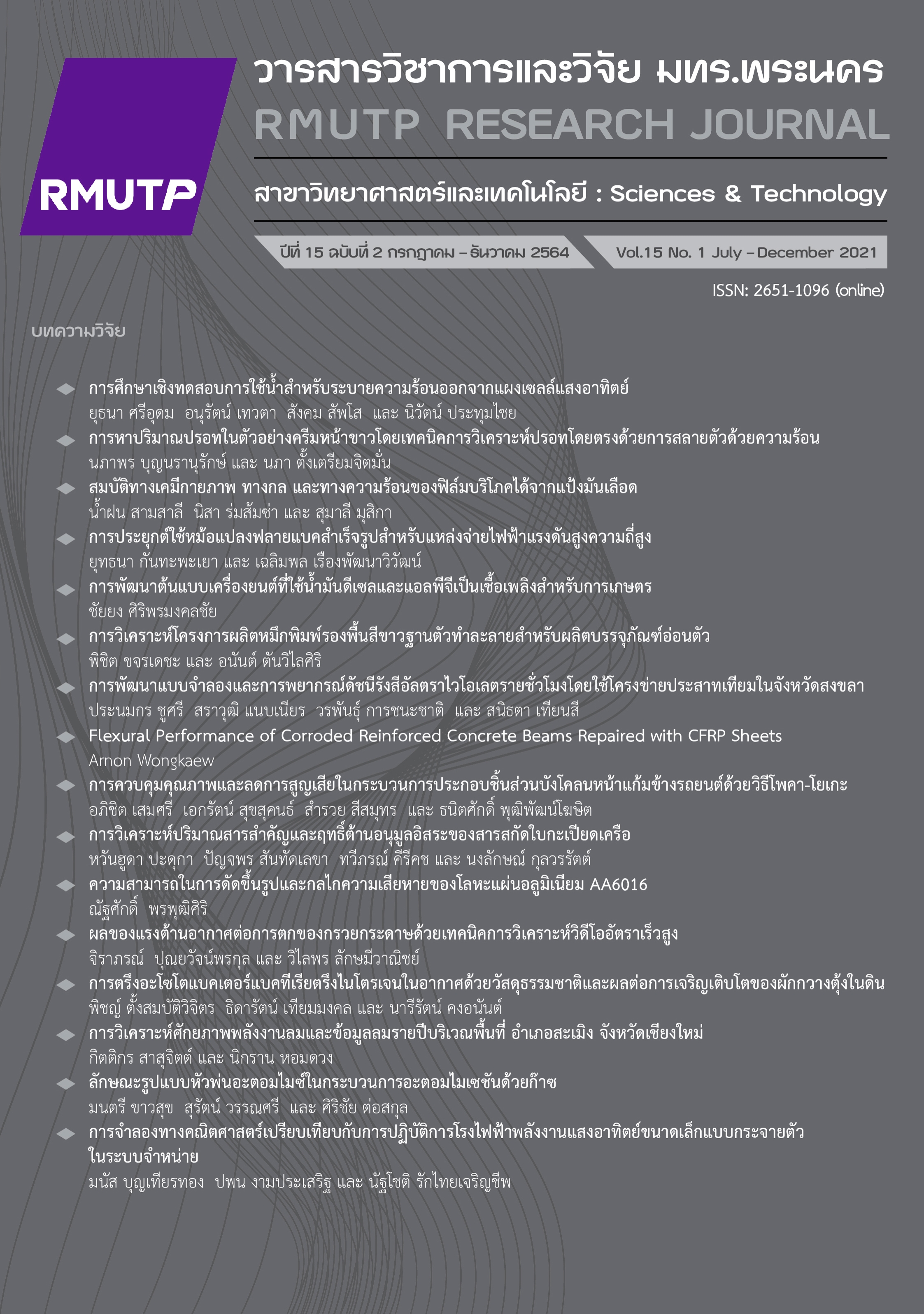การพัฒนาแบบจำลองและการพยากรณ์ดัชนีรังสีอัลตราไวโอเลต รายชั่วโมง โดยใช้โครงข่ายประสาทเทียมในจังหวัดสงขลา
Main Article Content
บทคัดย่อ
ในงานวิจัยนี้ ผู้วิจัยได้ทำการศึกษาความเข้มรังสีอัลตราไวโอเลตซึ่งเป็นรังสีที่มีผลต่อผิวหนังมนุษย์และเป็นสาเหตุหนึ่งที่ก่อให้เกิดโรคมะเร็งผิวหนัง โดยผู้วิจัยได้รวบรวมข้อมูลความเข้มรังสีอัลตราไวโอเลตที่ได้จากการวัดภาคพื้นดินในจังหวัดสงขลาและนำข้อมูลที่ได้มาคำนวณหาดัชนีรังสีอัลตราไวโอเลต จากนั้นผู้วิจัยได้ทำการพัฒนาแบบจำลองและวิธีการพยากรณ์ดัชนีรังสีอัลตราไวโอเลตโดยใช้โครงข่ายประสาทเทียม โครงข่ายประสาทเทียมที่ใช้จะประกอบด้วยชั้นอินพุต (Input Layer) ชั้นซ่อน (Hidden Layer) 2 ชั้น และชั้นเอาท์พุต (Output Layer) ซึ่งข้อมูลที่เป็นอินพุต ทั้งหมดมี 4 ตัวแปร ได้แก่ ความเข้มรังสีอัลตราไวโอเลตที่มีผลต่อผิวหนังมนุษย์นอกชั้นบรรยากาศโลก มุมเซนิธของดวงอาทิตย์ ค่าความลึกเชิงแสงของฝุ่นละออง และดัชนีเมฆ ซึ่งตัวแปรดังกล่าวมีผลต่อการเพิ่มและลดลงของดัชนีรังสีอัลตราไวโอเลต โดยโครงข่ายประสาทเทียมที่ได้นั้นสามารถคำนวณดัชนีรังสีอัลตราไวโอเลตรายชั่วโมงได้เป็นอย่างดี โดยมีค่าความคลาดเคลื่อนอยู่ในรูปของรากที่สองของค่าเบี่ยงเบนกำลังสองเฉลี่ย (Root Mean Square Difference, RMSD) และค่าเบี่ยงเบนจากความเอนเอียงเฉลี่ย (Mean Bias Difference, MBD) เท่ากับร้อยละ 12.8 และร้อยละ -2.4 ตามลำดับ จากนั้นผู้วิจัยได้ใช้ข้อมูลดัชนีรังสีอัลตราไวโอเลตรายชั่วโมงย้อนหลัง 7 วัน เพื่อพยากรณ์ดัชนีรังสีอัลตราไวโอเลตใน 1 วันหรือ 9 ชั่วโมงถัดไป (ตั้งแต่ 08:00 น.-16:00 น.) ใช้โดยอัลกอริทึมในโครงข่ายประสาทเทียมแบบเพอร์เซฟตรอนหลายชั้นและการเรียนรู้แบบแพร่ย้อนกลับ (Back Propagation Algorithm) ซึ่งพบว่าโครงข่ายประสาทเทียมสามารถพยากรณ์ได้ค่อนข้างแม่นยำ โดยมีค่าความคลาดเคลื่อนในรูป RMSD เท่ากับร้อยละ 17 และ MBD เท่ากับร้อยละ 0.3
Article Details

This work is licensed under a Creative Commons Attribution-NonCommercial-NoDerivatives 4.0 International License.
ลิขสิทธ์ ของมหาวิทยาลัยเทคโนโลยีราชมงคลพระนครReferences
WHO, O.M.d.l Santé, Global Solar UV Index: A Practical Guide, A joint recommendation of World Health Organization, World Meteorological Organization, United Nations Environment Programme, International Commission on Non-Ionizing Radiation Protection, WHO, Geneva, 2002.
A. A. Ghoneim, I.M. Kadad and M.S. Altouq, “Statistical analysis of solar UVB and global radiation in Kuwait,” Energy, vol. 60, pp. 23-34, 2013.
G.W. Petty, A First Course in Atmospheric Radiation, Sundog Publishing, Madison, Wisconsin, 2004.
L. Wang, W. Gong, Y. Ma, B. Hu, W. Wang and M. Zhang, “Analysis of ultraviolet radiation in Central China from observation and estimation,” Energy, vol. 5, pp. 764-774, 2013.
P. Koronakis, G. Sfantos, A. Paliatsos, J. Kaldellis, J. Garofalakis and I. Koronaki, “Interrelations of UV global/global/diffuse solar irradiance components and UV-global attenuation on air pollution episode days in Athens, Greece,” Atmospheric Environment, vol. 36, no.19, pp. 3173–3181, 2002.
A. Kylling, A. Dahlback and B. Mayer, “The effect of clouds and surface albedo on UV irradiances at a high latitude site,” Geophysical Research Letters, vol. 27, no. 9, pp. 1411–1414, 2000.
J. Calbó and J.A. González, “Empirical studies of cloud effects on UV radiation: A review,” Review of Geophysics, vol. 43, no. 2, Jun. 2005.
A. Lindfors and A. Arola, “On the wavelength dependent attenuation of UV radiation by clouds,” Geophysical Research Letters, vol. 35 no. 5, 2008.
B. Wenny, V. Saxena and J. Frederick, “Aerosol optical depth measurements and their impact on surface levels of ultraviolet-B radiation,” Journal of Geophysical Research Atmospheres, vol. 106, pp. 17311–17319, 2001.
S. Janjai, S. Buntung, R. Wattan and I. Masiri, “Mapping solar ultraviolet radiation from satellite data in a tropical environment,” Remote Sensing, vol. 114, pp. 682–691, 2010.
S. Buntoung, S. Janjai, M. Nunez, P. Choosri, N. Pratummasoot and K. Chiwpreecha, “Sensitivity of erythemal UV/global irradiance ratios to atmospheric parameters: application for estimating erythemal radiation at four sites in Thailand,” Atmospheric Research, vol. 148, pp. 24–34, 2014.
L. Wang, W. Gong, Y. Ma, B. Hu, W. Wang and M. Zhang, “Analysis of ultraviolet radiation in Central China from observation and estimation,” Energy, vol. 59, pp. 764-774, 2013.
S.S. Leal, C, Tíba and R. Piacentini, “Daily UV radiation modeling with the usage of statistical correlations and artificial neural networks,” Renewable Energy, vol. 36, pp. 3337-3344, 2011.
J. N. Latosinsk, M. Latosinska and J. Bielak, “Towards analysis and predicting maps of ultraviolet index from experimental astronomical parameters (solar elevation, total ozone level, aerosol index, reflectivity. Artificial neural networks global scale approach,” Aerospace Science and Technology, vol. 43, pp. 301–313, 2015.
A.F. McKinlay and B.L. Diffey, “A Reference Action Spectrum for Ultraviolet Induced Erythema in Human Skin,” CIE Journal, vol. 6, pp. 17-22, 1987.
M. Iqbal, An introduction to solar radiation, New York, Academic Press, 1983.
D. Cano, J. M. Monget, M. Albuisson, H. Guillard, N. Regas and L. Wald, “A method for the determination of the global solar radiation from meteorological satellite data,” Solar Energy, vol. 37, pp. 31–39, 1986.
E. Frank, M. A. Hall and I. H. Witten, The WEKA Workbench. Online Appendix for “Data Mining: Practical Machine Learning Tools and Techniques,” Morgan Kaufmann Publishers Inc, 4th ed, 2016.
F.S. Tymvios, S.C. Michealides and C. Skouteli, Estimation of surface solar radiation with artificial neural networks, In.V. Badeacu (Ed.) Modeling Solar Radiation at the Earth Surface, Springer, Berlin, 2008.
M.T. Hagan, H.B. Demuth and M.H. Beale, “Applying the artificial neural network to estimate the drag force for an autonomous underwater vehicle,” Open Journal of Fluid Dynamics, vol. 4, no. 3, pp. 334-346, 1996.

